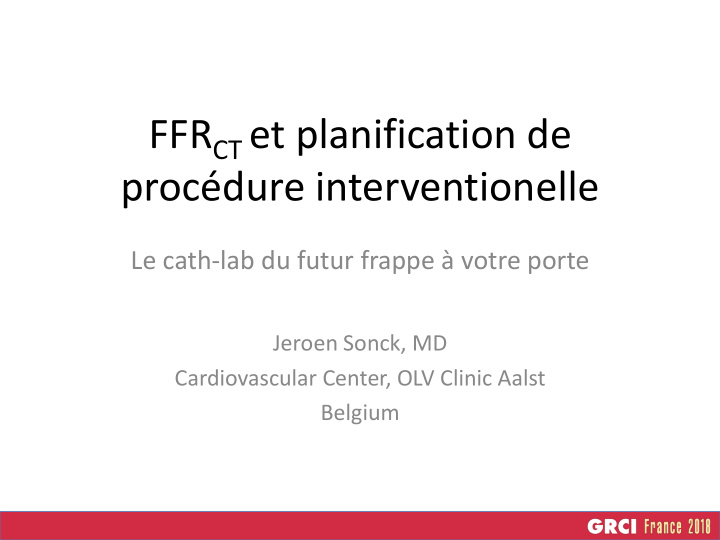



FFR CT et planification de procédure interventionelle Le cath-lab du futur frappe à votre porte Jeroen Sonck, MD Cardiovascular Center, OLV Clinic Aalst Belgium
DÉCLARATION DE LIENS D'INTÉRÊT AVEC LA PRÉSENTATION Intervenant : Jeroen SONCK, Aalst ☑ Je n'ai pas de lien d'intérêt à déclarer
Cardiovascular Center Aalst
Cardiovascular Center Aalst
Cardiovascular Center Aalst
Cardiovascular Center Aalst Patient selection using physiology at the vessel level is associated with improved clinical outcomes. MACE Myocardial infarction Xaplanteris P et al. NEJM 2018
Cardiovascular Center Aalst
The incremental value of CT-derived FFR on top of CCTA • 1/ Optimize patient selection for the lab – Vessel and lesion-specific physiology – Pre-lab MVD classification 2/ Plaque assessment ∾ • IVUS/OCT • 3/ Plan the percutaneous approach
Cardiovascular Center Aalst Diagnostic performance of FFR CT : PACIFIC trial Presented Euro PCR 2018, Driessen RS et al.
Cardiovascular Center Aalst SYNTAX II sub-study: Performance of FFR CT in patients with multivessel disease Mean FFR CT 0.67 (IQR 0.5 -0.81) Concordant Discordant (147) (31) n=178 AUC of 0.85 (95% CI: 0.79 to 0.90) Sensitivity 95 % (95% CI: 89% to 98%); specificity 61% (95% CI: 48% to 73%); positive predictive value 81% (95% CI: 76% to 86%) and negative predictive value 87% (95% CI: 74% to 94%). Collet, Sonck and Serruys, JACC 2018
Cardiovascular Center Aalst Major Adverse Cardiac Events in patients with deferred lesions based on FFR CT 12 months follow-up, n=977 20 0.2% adverse event rate at 12 Percentage (%) 15 months follow-up 10 4 5 0 0 0 0 0 Nǿrgaard PROMISE Jensen et SYNTAX II PLATFORM et al. n=50 al. n=32 n=117 Jensen et al. EHJCI. 2017 Lu, M. e.a. TCT 2015 n=123 n=655* PLATFORM. JACC 2016 90 days follow-up Collet et al. JACC 2018 Norgaard et al. JACC Imag. 2017
Cardiovascular Center Aalst Combined cCTA and FFR CT : ICA cancellations in high-risk patients 100 90 91% 80 70 75% 75% % of ICAs Cancelled 60 50 n=540 n=115 40 47% n=440 30 n=71 20 10 0 Low-Intermediate Risk High-Risk • A frontline cCTA and FFR CT testing strategy cancelled 75% of ICAs in the high-risk group • The incremental impact of FFR CT was greater in high-risk as compared with the low- intermediate risk group – 60% in high-risk versus 21% in low-intermediate risk Jensen et al, European Heart Journal – Cardiovascular Imaging 2017
Cardiovascular Center Aalst Ratio of cath/PCI: Cath-lab efficiency
Cardiovascular Center Aalst Reclassification of the SYNTAX-score tertiles versus Reclassification 30% FFR CT Coronary NRI=0.1 8 CTA Reclassification 23% NRI=0.2 ICA iFR 6 Weighted Kappa 0.19 Weighted Kappa 0.32 Collet, Sonck, Serruys et al. JACC 2018
Cardiovascular Center Aalst MVD classification before we enter the lab
Cardiovascular Center Ongoing trial: CABG Revolution Aalst CABG without ICA In patients with left main or three-vessel coronary artery disease, a heart team treatment decision-making based on coronary CTA showed an almost perfect agreement with the decision derived from conventional coronary angiography suggesting the potential feasibility of a treatment decision-making and planning based solely on this non-invasive imaging modality.
Cardiovascular Center Aalst Coronary Imaging: from vessel to plaque
Cardiovascular Center Aalst Newby et al. NEJM 2018
Cardiovascular Center Aalst High Risk Plaques and Clinical Outcomes
Cardiovascular Center Aalst Identification of High Risk Plaques Adverse Hemodynamic characteristics (AHC) defined as lesions that have low FFR CT (<0.80), high ∆FFR CT (>0.06) , high WSS (≥154.7 dyn/cm2 ), or high axial plaque stress (≥ 1,606.6 dyn/cm2 ). Lee et al. EMERALD trial. JACC Imaging 2018
Cardiovascular Center Aalst Treatment planning based on FFR CT Collet et al. Circulation 2018. Sonck et al. Circ Interv submitted.
Cardiovascular Center Aalst HeartFlow Interactive Revascularization Planner Stent Baseline LM PCI Mid LAD PCI Mid + distal LAD PCI Collet et al. Nature Reviews 2018.
Cardiovascular Center Aalst Case 1 Precise PCI Plan Study 1,0 0,63 FFR pre PCI 0,61 3.5/20 1,0 stent 0,94 0,88
Cardiovascular Center Aalst Case 2 Precise PCI Plan Study • 40 year old sportive male 24.0mm 2 • Asymptomatic 9.9 mm 2 8.4 mm 2 3.1 mm 2 Multiplanar reconstruction (MPR) 4.1 mm 2
Cardiovascular Center Aalst Case 2 Precise PCI Plan Study ± 34 mm
Cardiovascular Center Aalst Case 2 Precise PCI Plan Study FFR - One distal value
Cardiovascular Center Aalst ± 34 mm
Cardiovascular Center Aalst
Cardiovascular Center Aalst
Cardiovascular Center Aalst
Invasive vs. non-invasive treatment planning FFR post 0.87 FFR CT post 0.87 FFR pre 0.79 FFR CT pre 0.79
Cardiovascular Center Aalst The future of FFR CT : Mobile, On-Demand, Integrated & Interactive
Conclusion: FFR CT in the lab of tomorrow FFR CT enhances the non-invasive assessment of myocardial ischemia. Refine risk stratification with coronary physiology parameters on top of anatomy and known adverse plaque characteristics. May allow for decision-making between CABG and PCI and treatment planning in the non-invasive setting. Guide which lesions require an invasive assessment in the lab. Select the optimal revascularization strategy. Improve cathlab efficiency
Recommend
More recommend